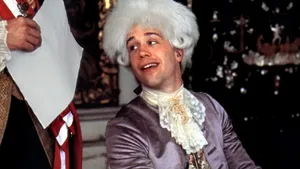Stay in the Loop
BSR publishes on a weekly schedule, with an email newsletter every Wednesday and Thursday morning. There’s no paywall, and subscribing is always free.
The astonishing truth about Mozart
Julian Rushton’s ‘Mozart’

After Mozart’s premature death in 1791 his widow, Constanze, apparently contributed a great deal of nonsense to her late husband’s memory, albeit not with any malevolent intent. And by now, thanks to popular entertainments like Peter Shaffer’s Amadeus, the legends and downright falsehoods about Mozart and his contemporaries are well known: He was a womanizer and a careless spendthrift; his father exploited his children’s talent; Salieri was a sworn enemy out to poison his young rival.
Julian Rushton has done a remarkable job of cutting Mozart’s mythology down to size, reducing it to a human level that does far more justice to Mozart’s greatness than any myth-making could. We’re often given to believe that music came easy to Mozart, for example. It certainly came easier to him than to most: Mozart was able to compose a finished work in his head and dash off opera overtures faster than most people can get to work in the morning. But Mozart also abandoned many projects in their early stages if they did not coalesce.
More than that: He recycled much of his own material— a standard compositional practice— and even used music written by others. His early piano concertos, for instance, borrow from J.C. Bach, among others; and the first movement of Mozart’s Requiem borrows material from Händel and its formal scheme from Michael Haydn.
In short, for all his talent, Mozart was a hard worker every bit as much as he was a towering genius.
Lack of depth
Rushton sought to condense Mozart’s life into one short, readable volume, and for all intents and purposes he succeeded. As the author points out, Mozart was an extraordinary man who lived a fairly ordinary life. So it wasn’t difficult to fit his biographical details into a volume just shy of 250 pages.
But in studying Mozart’s music itself, Rushton had to make sacrifices, and so he provides merely fleeting discussions of many of Mozart’s works, and many others were omitted altogether. This approach might be appropriate for an overview biography, but at the end of such short blurbs, the reader can be left feeling out of the loop for lack of depth. Yet ultimately no musical commentary can replace studying the score, and in fact Rushton’s book prompted me to do just that with a number of Mozart’s pieces.
High cost of clothes
Rushton makes quick work of some of the more popular fictions about Mozart. There’s no evidence that he was a womanizer, and although he tended to speak his mind, he enjoyed a fairly happy social life and was hardly the buffoon that some accounts would imply. Leopold, his father, far from being a selfish impresario, might well have considered it his fatherly duty to promote the talents of his young children Wolfgang and Nannerl— in fact, he made many sacrifices in doing so.
And while Mozart did have financial problems, there’s no evidence that he squandered his money on partying. On the contrary, many expenses that look like luxuries on paper— fancy clothes, for instance— were likely required for Mozart to be accepted in high society, where he could find patrons sufficiently wealthy to support him.
Hidden revolution
Mozart wrote for the aristocracy, so his work was largely circumscribed by their musical tastes. Rushton points out, however, that Mozart was able to engage in unique compositional treatment within the fashionable styles of his day, using what might be called the Three C’s: counterpoint, chromaticism and comedy.
More than that, he indulged in daring formal schemes, such as the Finale from Act II of The Marriage of Figaro, which mimics sonata form on a large scale— perhaps a hidden revolution under the surface of what was then the accepted style.
Scholars who demystify old cherished myths perform an often thankless task, since it can seem like the writer’s just trying to ruin our fun. (As the cynical Western newspaper editor remarked in The Man Who Shot Liberty Valance, “When the legend conflicts withy the truth, print the legend.”) It’s much more exciting to think of Salieri as Mozart’s sworn enemy rather than a cordial colleague. It’s also more juicy to imagine Wolfgang indulging in dalliances, spending money carelessly and dying dressed in rags. But none of this is really true.
His immense musical talent aside, Mozart was a pretty ordinary guy, and the word is starting to get out, thanks to scholars like Rushton. We owe him and his colleagues an enormous debt of gratitude, since only in the framework of Mozart’s fairly ordinary life of hard work can we truly grasp the extraordinariness of the music he has given us.
What, When, Where
Mozart. By Julian Rushton. Oxford University Press, 2006. 320 pages; $31.99. www.amazon.com.
Sign up for our newsletter
All of the week's new articles, all in one place. Sign up for the free weekly BSR newsletters, and don't miss a conversation.
